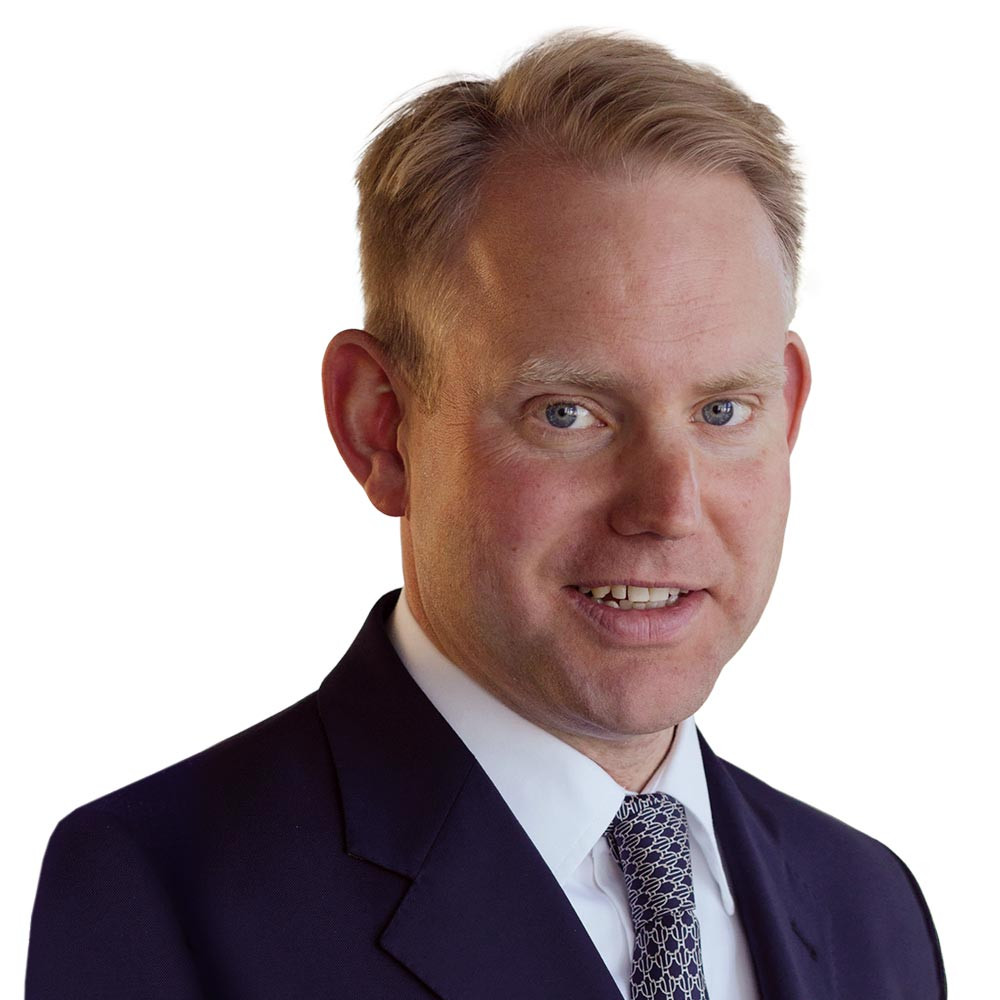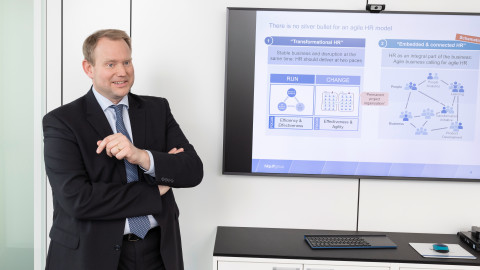The hkp/// group Transformation Lab recently brought together decision-makers from HR management to discuss aspects of development, dismantling, and transformation within companies. hkp.com talked to Petra Knab-Hägele and Johannes Brinkkötter to find out about the views on transformation shared there.
Ms. Knab-Hägele, Mr. Brinkkötter, the term transformation is in danger of becoming an empty phrase; it somehow describes everything and nothing at the same time. What exactly is transformation all about?
Petra Knab-Hägele: Companies have always adapted and transformed in response to changing conditions in order to become or remain competitive – sometimes quite drastically so. Take a look at Nokia, which once manufactured rubber boots in Finland, then became the world market leader in cell phones, and now operates as a global network supplier. But while such developments used to take place in fairly contained phases, today's companies are in a permanent state of flux, with the speed of change increasing at the same time. When we talk about transformation now, we mean the necessary change an organization needs to make in order to achieve its desired strategic goal.
Johannes Brinkkötter: ... and this vision is itself subject to a whole range of dynamic influences and is no longer as rigid as it was in the past. To achieve their objectives, companies have to change or scale back existing corporate structures, or take on or tap into new areas – in other words build up, dismantle or restructure, and this increasingly has to happen in different areas of business at the same time.
In your opinion, what has caused this dynamization of the corporate world?
Petra Knab-Hägele: In addition to digitization, which is probably the most obvious driver of structural change, there are a number of other factors whose impact has increased continuously as a result of the increasingly rapid and widespread digitization of our living and working environments. Of course, the Corona pandemic has also acted as an amplifier of this dynamic.
What would you say are the key drivers?
Petra Knab-Hägele: We are currently experiencing a trend toward greater individualization and customer centricity, which involves seeing products and services through the eyes of the customer more acutely than ever before and responding more flexibly to the individual needs of customers.
Johannes Brinkkötter: Plus, today's companies are no longer solely concerned with optimizing processes, reducing costs, or maximizing profits, they also have a much greater interest in sustainable, environmentally conscious, and resilient business practices. Investors and regulators now have clear expectations in this respect. What's more, the Covid pandemic has made the trend toward New Work irreversible, and a demographically driven labor market is forcing companies to adopt employee-focused work environments in the sense of offering an attractive work-life balance within increasingly agile work settings.
To what extent did the case studies presented at the hkp/// group Transformation Lab reflect the developments you have outlined? Were there any ideal transformation scenarios?
Johannes Brinkkötter: If there is one key insight from our transformation projects, it’s that there isn’t a universal solution. Every company is unique, every business model is individual, and so are the specific conditions and objectives. The company-specific presentations by Bosch Power Tools, Zur Rose Group, and Siemens Energy at the event were correspondingly diverse.
Can you outline the main points of the challenges faced by these companies?
Petra Knab-Hägele: With the carve-out from the Siemens Group and the stock market flotation shortly after, Siemens Energy embarked on a tour de force that got off to a successful start but is still ongoing, although tasks of course change over time. In terms of the challenges facing HR in particular, the focus today, as it was at the start, is on the harmonization and standardization of processes and tools alongside the establishment of new structures. These aspects were underscored by Vice President Peter Dodell, who is responsible for Standardization & Harmonization within the Group.
Johannes Brinkkötter: The Zur Rose Group originated as a Swiss pharmaceutical distributor and has, through strong organic and inorganic growth following its IPO, earned the status of Europe's largest online pharmacy with its Doc Morris brand. hkp/// group had the pleasure of supporting the development and implementation of the group’s functional strategy. The fact that the company has now decided to focus on the end-customer side of things and the introduction of electronic prescriptions, particularly in Germany, and to sell its Swiss business to the Swiss Migros Group, can be seen as evidence of the pressure to act and the drive for change that we are facing today. And the decision is also, according to Thomas Biegerl, Program Manager at Zur Rose Group, an impetus for change in the business model and consequently for a HR department that has defined employee centricity as a key success factor.
Petra Knab-Hägele: In turn, Luisa Brandt, Global Head of HR at Bosch Power Tools, painted a very clear picture of the willingness to change and transform that is needed to remain competitive and agile as a successful, world-class brand company. Even if not all aspirations were met during this intensive process, and incorporating agility into the organization through more than 50 speedboats entails risks, she emphasized, “Change is inevitable; it's the response to it that matters.”
Given all the differences between the projects described, were there any common threads?
Johannes Brinkkötter: There definitely were. I'd say that People Operations plays a crucial role here: if HR is in the transformation driver's seat, then the foundation is laid to ensure that the perspectives and needs of employees are taken into account appropriately and at an early stage. No transformation in this world can be successful without people.
Petra Knab-Hägele: I would also include courage as a key success factor for transformations, courage to act in general, but also in terms of HR implementing agile processes and using modern, oftentimes AI-based tools.
Johannes Brinkkötter: Topics such as sustainability and ESG play an important role as well; they have become part of every HR functional strategy, which in many of today's companies focuses primarily on supporting/implementing business transformation.
What specific role does HR play in these transformation scenarios?
Johannes Brinkkötter: It has two! On the one hand, HR has to transform itself in line with the new objectives, define strategic priorities, and review and adapt its own portfolio of tools, including its delivery model. On the other hand, HR is a definitive facilitator and implementer of change, and in the best-case scenario, a valued mediator working alongside management. With the relevant transformation expertise, a capable HR function that operates group-wide is indispensable.
What are the specific tasks and challenges for HR that arise from different types of transformation?
Petra Knab-Hägele: The range of tasks facing HR in effectively supporting and accompanying transformation projects is broad, diverse and, as already mentioned, is different from project to project.
What are the top priorities from your point of view?
Petra Knab-Hägele: Let's start with corporate vision and culture. HR has to create a new, credible identity in the company in line with the new business strategy and based on previous cultures. This isn't a case of flipping a switch, but a lengthy process that always has to be linked to leadership culture as well.
Johannes Brinkkötter: And leadership itself is a central aspect, meaning the new appointment of, and support for, key management positions in the new company. The emphasis is on defining the values, competencies and responsibilities of those in management, including relevant retention and incentivization measures, and leadership training.
Employee retention and incentives are always critical in change processes...
Johannes Brinkkötter: Without a doubt! Effective talent management processes and systems need to be developed to ensure that the right people with the required skills are effective in the right roles in the short, medium and long term. Transformation offers a wealth of development opportunities, but it also leads to disappointments. For this reason, opportunities and risks relating to careers, especially those critical to success, need to be re-evaluated and communicated in the light of modified corporate objectives.
Petra Knab-Hägele: This realignment also applies to employee and management compensation. Compensation is always an expression of a company's strategy and culture. It can support transformation and the envisioned corporate culture. That's why all compensation systems are also subject to review during the transformation process. How much of a collective share is appropriate? What role should individual performance play in compensation? How can ongoing learning be taken into account in compensation? Does compensation at top management level meet all legal and regulatory requirements? Is it still appropriate as it stands?
Transformations often involve the reorganization of areas, changes in the scope of functions, etc. How important do you think such aspects are?
Petra Knab-Hägele: Extremely important! Realigning business and employee areas to fit the changing company is usually part of any transformation project, as is the matching of ACTUAL and TARGET employee levels in terms of quantity and qualifications. What is the current status of the relevant positions? Where is clarification needed and in which areas or countries do positions need reappointing or appointing in the first place? What does our target structure and management make-up look like?
Johannes Brinkkötter: Whatever applies to the strategy-based reorganization of functions, structures, and processes in terms of resourcing, i.e., amount and costs, also applies to the same extent to the dimensioning and organization of HR itself.
So, to finish: what are the key success factors needed to ensure that HR operates effectively in transformation projects?
Petra Knab-Hägele: There needs to be a clear vision set for the new or adapted company. If there isn’t such a vision in place, it is up to HR to push for this from management, or to collaborate in developing one. Leading on from this, appropriate planning and prioritization of measures is indispensable: Which products pay into the HR strategy? What does an efficient, employee-centric HR structure look like?
Johannes Brinkkötter: And even if it sounds a bit clichéd, the most important factor for the success of change projects is people. Employees and managers need to be approached and involved in a targeted manner. Only then, depending on the task at hand, can integration or cultural change succeed.
Ms. Knab-Hägele, Mr. Brinkkötter, thank you for talking to us.



